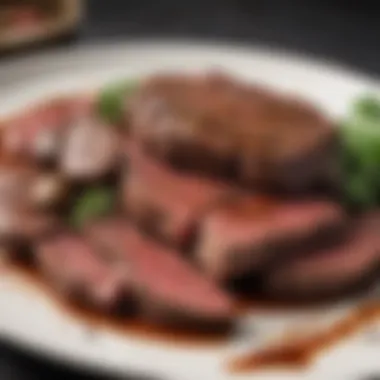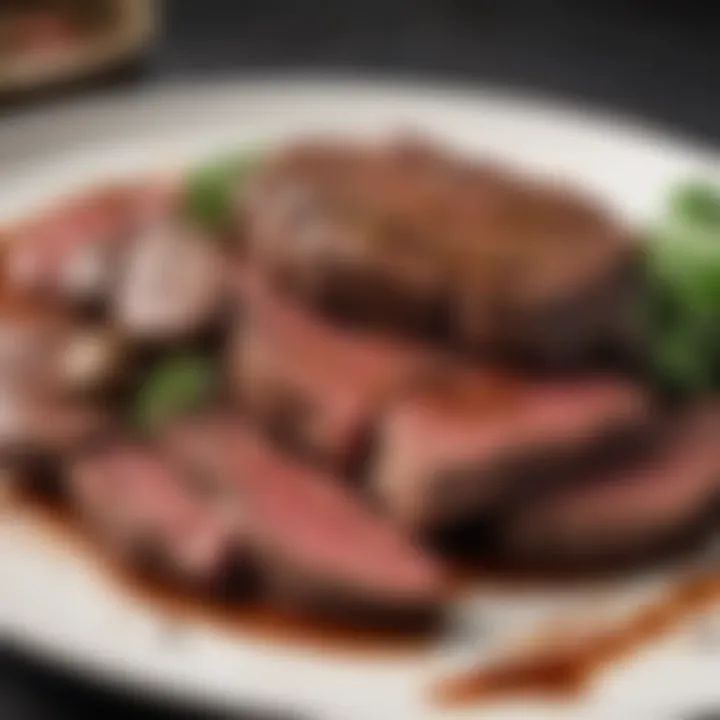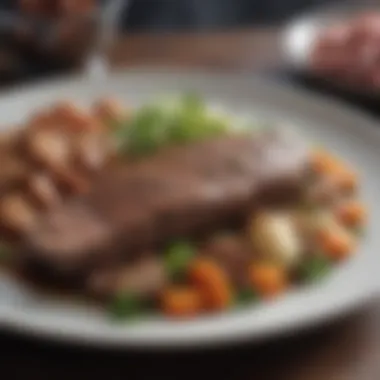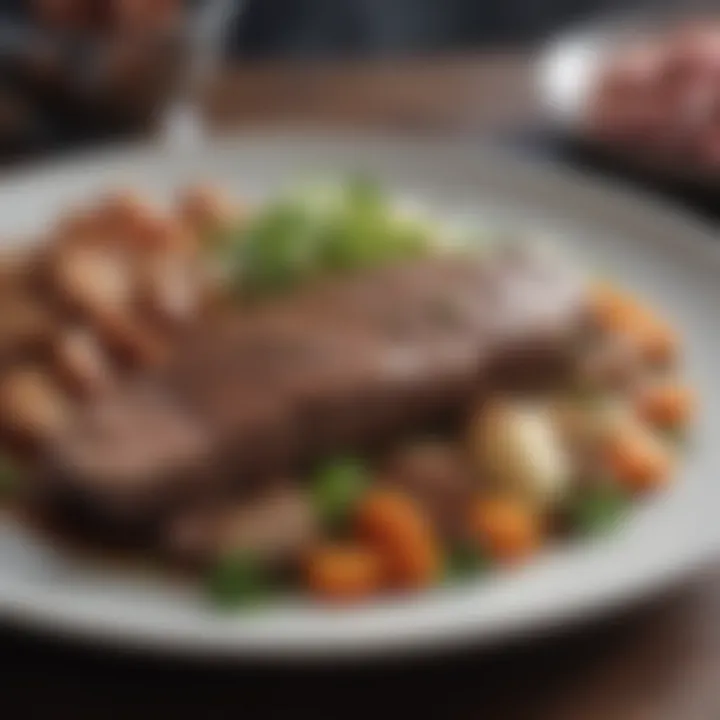How to Cook Beef Liver for Dogs and Cats Safely


Intro
Beef liver is a highly nutritious organ meat that offers significant health benefits for dogs and cats. It is rich in vitamins, minerals, and proteins, making it a valuable addition to any pet's diet. However, it is crucial for pet owners to understand how to properly prepare and serve this food to their pets. This article serves as a comprehensive guide to cooking beef liver for dogs and cats, offering insights into nutritional benefits, safe preparation methods, and thoughtful feeding practices.
Pet Care and Grooming
Importance of Regular Care
Basic care and grooming are essential for the well-being of your pets. Regular grooming not only helps maintain their cleanliness but can also provide early detection of health issues. For liver consumption, cleaning your pet’s feeding areas and grooming them helps prevent contamination and ensures safety. Additionally, routine check-ups with a veterinarian can ensure that your pets are healthy and that their diet meets their needs.
Grooming Techniques by Pet Type
Different pets require different grooming techniques. For dogs, brushing their fur regularly can reduce shedding and matting. Cats may need less frequent brushing but still benefit from it, especially long-haired breeds. During grooming sessions, it can be a good moment to inspect your pet's overall health, including any potential issues that may arise from diet changes.
Tools and Products Recommendations
Invest in good quality grooming tools. For dogs, a slicker brush and a de-shedding tool are beneficial. For cats, a soft brush will often suffice. When it comes to feeding, stainless-steel bowls are recommended due to their durability and ease of cleaning.
Seasonal Care Tips
Pets often need different kinds of care depending on the season. In winter, make sure your pets are warm, especially if they have short fur. In summer, keep them hydrated and consider grooming them to help them stay cool. Being mindful of changing their diet based on seasonal needs is also important.
Health and Nutrition
Understanding Pet Nutrition
Understanding the nutritional needs of your pets is fundamental. Dogs and cats require a balanced diet that includes proteins, fats, carbohydrates, vitamins, and minerals. Beef liver can serve as a protein source while supplying essential nutrients.
Common Health Issues by Species
Certain health issues in dogs and cats can be linked to their diet. For example, obesity is a common issue for both. Incorporating beef liver in moderation can help maintain a healthy weight. However, pets with pre-existing conditions, particularly liver problems, should avoid this organ meat or be given it in minimized quantities.
Preventive Care and Regular Check-Ups
Regular veterinary visits are important to discuss your pet’s diet and health. A vet can provide guidance on how much liver is appropriate based on your pet's age, size, and health status. Preventive care is essential for avoiding potential issues before they develop.
Food and Dietary Advice
When introducing beef liver to your pet's diet, start with small amounts to assess their tolerance. It can be served cooked, ensuring that harmful pathogens are eliminated while preserving the nutrients. Rotate it with other protein sources for balanced nutrition.
Proper preparation of beef liver enhances its nutritional benefits while ensuring your pet's safety.
Behavioral Training
Basics of Positive Reinforcement
Training your pet to enjoy new foods, like beef liver, can involve positive reinforcement. Reward them with praise or small treats when they try or eat the liver. This encourages acceptance and can create a positive association with new foods.
Training Techniques Users Can Apply
Consistency is key when training pets. When introducing liver, use it in conjunction with established commands. This technique teaches them to respond to cues while enjoying a new delicacy.
Managing Behavioral Issues
An understanding of your pet’s behavior can lead to a more harmonious feeding routine. If your pet shows reluctance to try beef liver, patience is essential. Gradually incorporate it into their meals without pressure.
Importance of Socialization
Socialization helps pets feel comfortable in different situations, including trying new foods. Including the new food during social activities can encourage your pet to engage positively and accept beef liver as part of their diet.
Engaging Activities and Enrichment
Fun Games to Play with Your Pet
Enrichment is crucial for pets. Engaging them in games provides mental challenges and can lead to greater interest in new foods. Consider using liver as a treat during training games.
DIY Toys and Activities
Creating toys from safe materials can stimulate your pet’s curiosity further. This encourages them to discover and explore flavors when served liver.
Importance of Mental Stimulation
Mental stimulation is essential for your pet’s development. Puzzle feeders can introduce new foods in an engaging way. Filling them with liver can attract your pets’ interest while promoting problem-solving.
Outdoor Adventures and Exploration
Take your pets outdoors for physical activity. Engaging them in nature can enhance their appetite, making them more receptive to new foods like beef liver when they return home.
Resources and Community Engagement
Recommended Books and Websites
For further reading on pet nutrition and care, consider looking at resources like Wikipedia and Britannica. Both offer valuable insights into animal health and nutrition.
Forums and Groups for Pet Owners
Joining online communities on platforms like Reddit or Facebook can provide peer support. Engaging with other pet owners can give you new ideas on incorporating liver and other nutritious ingredients into your pets' diets.
Finding Local Services and Classes
Many local communities offer workshops on pet care and nutrition. Finding these resources can improve your knowledge and help implement healthy practices for your pets.
Encouraging Community Sharing and Contributions
Sharing your experiences with cooking for pets can help others. Consider contributing to community forums focused on pet nutrition or care, promoting a culture of shared knowledge and experience.
Intro to Beef Liver for Pets
Beef liver is often regarded as a nutritional powerhouse for pets, particularly for dogs and cats. This section serves to elucidate its significance in a pet's diet and underline the key benefits of incorporating this organ meat.


The trend among pet owners is shifting towards natural, raw ingredients. Beef liver stands out because of its dense concentration of vitamins and minerals, essential for the well-being of pets. When pets consume beef liver, they gain access to important nutrients that can bolster their overall health.
It's essential to understand that while liver is a nutrient-rich food, moderation is key. Overfeeding liver can lead to various health issues due to its high vitamin A content. Hence, the right balance must be achieved. Understanding the proper serving and preparation methods is critical in safeguarding pet health while maximizing benefits.
Nutritional Profile of Beef Liver
Beef liver provides an impressive array of vitamins, minerals, and protein. These aspects play a significant role in enhancing overall health and supporting different physiological functions in pets. Let’s examine this in greater detail.
Vitamins and Minerals
Beef liver is an excellent source of vital vitamins and minerals. It is particularly rich in Vitamin A, Vitamin B, iron, copper, and zinc. These nutrients contribute to various bodily functions, promoting healthy skin, improved vision, and enhanced immune systems in pets.
- Key characteristic: The high level of Vitamin A makes it a unique food choice because it benefits vision and overall vitality.
- Unique feature: The presence of copper aids in forming red blood cells and maintaining bone health, making it especially beneficial for older pets.
- Advantages: Beef liver is a powerful ally in nutritional diets, given its dense nutrient profile.
Protein Content
The protein found in beef liver is of high biological value, meaning it contains all essential amino acids required by pets. This makes it a superb choice for maintaining muscle health and overall body functionality.
- Key characteristic: The high protein quantity aids in muscle development and repair, crucial for physically active dogs.
- Unique feature: Protein from liver is easily digestible, allowing pets to absorb nutrients efficiently.
- Advantages: Incorporating beef liver provides additional protein, which is a vital aspect of a balanced diet for both dogs and cats.
Health Benefits for Dogs and Cats
Incorporating beef liver into a pet's diet can confer several health benefits that are important for their overall well-being. It supports different aspects of health depending on the specific needs of dogs and cats.
- Key characteristic: Beef liver promotes better liver function and metabolic health, which is especially valuable for aging pets.
- Unique feature: Its richness in nutrients supports not only physical health, but also cognitive function as pets age.
- Advantages: By including beef liver in the diet, pet owners can ensure their pets receive comprehensive nutritional support, often leading to a healthier, more active life.
Including beef liver in your pet's meals can yield significant health improvements. However, consultation with a veterinarian is advisable to determine appropriate serving sizes.
Understanding the Risks and Precautions
Cooking beef liver for dogs and cats presents unique challenges and responsibilities. It is important to fully understand potential risks before introducing liver into your pets' diet. A well-informed pet owner can help avoid health complications. This section covers necessary precautions, including allergic reactions and safe handling practices. Both are critical elements in ensuring the well-being of your furry companions.
Possible Allergies and Intolerances
Allergic reactions to beef liver, while not extremely common, can occur in some dogs and cats. Symptoms may include itching, rashes, gastrointestinal upset, and even more severe reactions. Here are a few key points to consider:
- Observe closely: If you are introducing beef liver for the first time, monitor your pet's reaction carefully. Note any changes in behavior or health.
- Take it slow: Begin with a small amount of liver. Gradually increase the portion over several days to see how your pet responds before committing to regular feeding.
- Consult your vet: If your pet has a history of food allergies, discuss the introduction of beef liver with your veterinarian. They can recommend personalized strategies tailored to specific dietary needs.
It is crucial to recognize that signs of an allergic reaction can overlap with other conditions. Therefore, a thorough understanding of your pet’s medical history is key.
Handling and Storage Safety
Proper handling and storage of beef liver are essential to ensure your pet's food is both safe and nutritious. Here are some best practices:
- Clean surfaces and utensils: Always sanitize surfaces and tools used to prepare liver. This helps prevent contamination from bacteria, which can cause serious health issues for pets.
- Storage temperature: Raw liver should be stored in the refrigerator and kept at a consistent temperature below 40 degrees Fahrenheit. It can also be frozen if not used within two to three days.
- Thawing: If using frozen liver, thaw it in the refrigerator, not at room temperature. This reduces the risk of bacterial growth.
- Dispose carefully: Any uneaten liver should not be left out for long periods. Discard leftovers after a couple of hours to minimize health risks.
Tip: Use separate cutting boards for raw meats and other foods to avoid cross-contamination.
Following these handling and storage guidelines can keep your pet free from foodborne illnesses. Each step serves as a preventive measure that contributes to their overall health.
Selecting Quality Beef Liver
Choosing the best beef liver is vital for ensuring your pets gain maximum nutritional benefits. The quality of the liver directly influences the health and happiness of your dogs and cats. Selecting high-quality beef liver means you are providing a nutritious food source that supports their overall health.
Organic vs.
Conventional Liver
When deciding between organic and conventional liver, understanding the differences can impact your choice. Organic beef liver comes from cattle that are raised without synthetic hormones, antibiotics, or pesticides. This means that organic liver typically contains fewer chemical residues, which is beneficial for your pets' long-term health. Moreover, organic farming often promotes better animal welfare.
Conventional liver, while still nutritious, may come from animals that were given treatments that can affect the meat's quality. These treatments could lead to potential exposure to harmful substances. However, conventional liver is often more accessible and less expensive than its organic counterpart.
Ultimately, the choice between organic and conventional liver depends on your access, budget, and your pet's specific dietary needs. Always look for reputable sources when purchasing either type.
Freshness Indicators
To ensure you select the best liver, always look for freshness indicators. Fresh beef liver should have a deep reddish-brown color, signaling that it is high quality. If the liver appears dull or has a grey hue, it may be old or spoiled.
Additionally, consider the texture. A fresh liver will feel moist and slightly firm to the touch. If it is slimy or dry, it is best to avoid purchasing it. Another critical aspect is the smell. Fresh liver should have a mild, neutral odor. If it has a rancid or unpleasant smell, it is crucial to discard it.
Here are some tips for ensuring liver freshness:
- Check expiration dates on packaging.
- Purchase from reputable retailers or local suppliers.
- If possible, buy liver from a butcher you trust to provide fresh products.
By paying attention to these details, you ensure that your pets are getting only the freshest and most nutritious beef liver available.
Preparation Methods for Cooking Beef Liver
Cooking beef liver properly is crucial for pet owners seeking to provide a nutritious meal for their dogs and cats. Various preparation methods can influence not only the taste and texture of the liver but also retain or reduce its nutritional value. Understanding different cooking methods allows pet owners to adapt their approach according to their pets' preferences and dietary needs.
Cleaning and Preparing the Liver
Before you begin cooking, it is essential to clean and prepare the beef liver properly. This step is vital in ensuring the liver is safe and fit for consumption.
- Rinsing: Start by rinsing the liver under cold water. This removes any residual blood or impurities.
- Trimming: Inspect the liver for any connective tissue or fat. Trim away any undesirable parts, as they can give a less pleasant texture to the final meal.
- Slicing: Consider slicing the liver into smaller portions. Smaller pieces cook more evenly and are easier for pets to chew.
Following these prep steps not only enhances the meal's appeal but also ensures a healthier outcome for your pets.
Cooking Methods Overview
There are several effective methods for cooking beef liver, each with unique benefits. Understanding these methods helps to retain flavor and nutritional value.
Boiling
Boiling involves submerging the liver in water and cooking it at a high temperature. This method is straightforward. It can minimize the strong taste of liver, which some pets might find overwhelming.
- Benefits: Boiling helps in retaining a significant amount of nutrients, especially water-soluble vitamins. It is also less likely to introduce additional fats or oils, making it a lower-calorie option.
- Disadvantages: One drawback is that boiling can sometimes lead to a rubbery texture if overcooked. Additionally, some flavor may be lost in the cooking water.
Pan-Frying
Pan-frying cooks the liver in a small amount of oil over medium heat, resulting in a crispy exterior while keeping the inside tender. This method is popular for its rich flavor development.


- Benefits: The quick-cooking process often enhances the liver's flavor due to browning. The added fat can help make the liver more palatable to pets who prefer richer tastes.
- Disadvantages: It is crucial to avoid overcooking, as high heat can create a tough texture. Additionally, if too much oil is used, it can increase calorie content unnecessarily.
Baking
Baking is another method where the liver is placed in an oven and cooked evenly. This method can be appealing for those looking to keep the cooking process hands-off.
- Benefits: Baking allows even cooking without added fats. It is also easy to prepare multiple liver portions at once, making it efficient for meal prep.
- Disadvantages: The cooking time is generally longer, and there's a need to monitor closely to prevent drying out the liver.
Adding Ingredients
Incorporating different ingredients with the liver can enhance its flavor and nutritional profile. Ingredients like vegetables or spices can be added during cooking.
- Benefits: This method allows for creative meals. Adding ingredients can provide extra vitamins and minerals, making it a more complete meal for pets.
- Disadvantages: Always ensure that any added ingredients are safe for pets. Some spices can be harmful, and it is vital to avoid any harmful foods.
Choosing the right preparation method for cooking beef liver can significantly impact the meal's health benefits and appeal to your pet. With careful consideration, you can ensure that your pets enjoy a nutritious diet.
Cooking Beef Liver: Step-by-Step Guide
Cooking beef liver for pets is essential in ensuring their meals are both nutritious and safe. This section provides a systematic approach to cooking beef liver, emphasizing the methods that best preserve its vital nutrients while catering to the dietary needs of dogs and cats. Understanding these techniques enhances the pet-owner's ability to support their pet's overall health through quality feeding practices.
Boiling Beef Liver
Boiling is a straightforward method for cooking beef liver. This technique helps retain the liver's rich nutrient content while making it tender for pets. Here’s a step-by-step process to boil beef liver:
- Preparation: Begin by rinsing the beef liver under cold water. Remove any visible membranes or fat, as these can hinder digestion in pets.
- Cutting: Cut the liver into smaller pieces to ensure even cooking. This also makes it easier for your pets to eat.
- Boiling: Place the liver pieces in a pot filled with enough water to cover them completely. Bring the water to a boil, then reduce heat to a simmer. Cook for about 15-20 minutes. Ensure the liver is cooked through but not overdone, as excessive cooking can lead to nutrient loss.
- Cooling: After boiling, allow the liver to cool completely before serving. This prevents burns in your pets.
- Serving: Cut the boiled liver into bite-sized pieces suitable for your pet's size.
Boiling is advantageous because it eliminates many harmful bacteria, making it a safe option for your pets.
Pan-Frying Beef Liver
Pan-frying is another popular method for preparing beef liver. This technique gives a unique flavor while keeping the inside moist. It is a quick method that ensures minimal nutrient loss.
- Preparation: Rinse the liver and remove any unwanted parts. Dry the liver with paper towels to assist in searing.
- Heating the Pan: Heat a non-stick skillet over medium-high heat and add a small amount of oil, like olive or coconut oil.
- Cooking Time: Once the oil is hot, place the liver in the pan. Cook each side for about 2-3 minutes. The key is to achieve a nice sear while keeping the inside slightly pink, which safeguards moisture and nutrients.
- Cooling and Slicing: Allow the liver to cool slightly before cutting it into manageable pieces.
Pan-frying creates a flavorful crust that many pets enjoy, making it a popular choice for pet owners.
Baking Beef Liver
Baking is a healthier cooking method that involves less fat compared to frying. It also allows the liver to cook more evenly. Here’s how to bake beef liver effectively:
- Preparation: Preheat the oven to 350°F (175°C). Rinse the liver and trim it as necessary.
- Baking Sheet: Place the liver onto a baking sheet lined with parchment paper.
- Seasoning: You may add minimal seasoning if desired, but keep it pet-friendly. Avoid salt and spices that could be harmful.
- Cooking Time: Bake the liver for about 25-30 minutes. Check that it is cooked through without becoming overly dry.
- Cooling: Let the liver cool before slicing or serving.
Baking can be beneficial for pet owners wanting a no-fuss method while ensuring even heat distribution and flavor retention.
Cooking liver properly is crucial to enhance its nutritional benefits for your pets, ensuring a healthy addition to their diets.
Post-Cooking Considerations
Understanding post-cooking considerations is critical in ensuring that your pets receive the benefits of beef liver safely. Proper cooling and storage methods for cooked liver can help maintain its nutritional value while preventing any potential foodborne illnesses. Additionally, feeding guidelines will aid you in determining the right portion sizes suitable for your dog or cat, thereby supporting their overall health.
Cooling and Storing Cooked Liver
After cooking beef liver, it becomes essential to cool it down rapidly to prevent bacterial growth. Leaving it at room temperature for too long can create a risk of contamination. Here are key steps to follow:
- Immediate Cooling: Once the liver is cooked, remove it from the heat source promptly.
- Cutting for Quick Cooling: If the liver is large, consider cutting it into smaller portions. This will allow it to cool faster and more evenly.
- Refrigeration: Transfer the cooled liver into an airtight container or a sealed plastic bag. Make sure the liver is stored in the refrigerator within two hours of being cooked to maintain freshness.
- Freezing for Longer Storage: If you do not plan to use the liver within a few days, consider freezing it. Cooked liver can stay frozen for up to three months. Wrap it tightly in plastic wrap and then place it in a freezer-safe container.
Remember to label the container with the date of cooking. This practice will help you keep track of how long the liver has been stored.
Feeding Guidelines
Feeding guidelines are necessary to ensure your pets benefit from beef liver without overdoing it. Here are some important points:
- Portion Size: The serving size should be appropriate for the individual pet. A general rule is to offer no more than 10% of their daily caloric intake as liver. For example, a medium-sized dog may receive a piece weighing about 2 ounces. For smaller dogs or cats, a piece of half an ounce might be suitable.
- Frequency of Feeding: Liver can be rich in nutrients, but it should not be a daily staple. Offering it once or twice per week is advisable. This prevents the risk of nutrient imbalances that may arise from excessive intake.
- Monitor Reactions: After introducing beef liver, observe your pet for any odd behaviors or digestive changes. If they show any signs of discomfort, reducing the portion size or frequency may be necessary.
It's worth emphasizing that while beef liver is a nutritious addition to your pet's diet, moderation is key to avoiding adverse effects.
By adhering to these guidelines regarding cooling, storing, and feeding your pets, you can ensure that incorporating beef liver into their diet is both safe and beneficial.
Incorporating Beef Liver into Meals
Incorporating beef liver into the meals of dogs and cats is a nuanced subject that deserves careful consideration. This organ meat is not only nutrient-rich but can also enhance the flavor profile of a pet's diet. Understanding how to properly mix liver with regular food can lead to improved health and vitality in pets.
Mixing with Dry or Wet Food
When deciding how to mix beef liver with your pet's regular food, both dry and wet options have their advantages.
- Dry Food: Mixing cooked beef liver into dry kibble can increase palatability without overly altering the texture. Consider finely chopping or grinding the liver to ensure it disperses easily throughout the kibble. This method works well for dogs and cats who may need the crunch of kibble in their diet. Always start with small amounts and observe how they respond.
- Wet Food: For those feeding wet food, incorporating beef liver is simpler and may yield a more aromatic meal. Simply slice or mash the liver and mix it in. The moisture from wet food can aid in ensuring that your pet consumes the liver. It's preferable to use fresh, cooked liver rather than raw if you are concerned about potential bacteria.
Homemade Treats with Beef Liver
Creating homemade treats using beef liver is a rewarding process that allows pet owners to control the ingredients while providing a nutritious snack. Here are some key considerations for making these treats:
- Simple Recipes: A basic recipe may consist of finely chopped or pureed cooked beef liver mixed with other healthy ingredients such as oats, eggs, or pumpkin. This combination can create a dough that can be rolled out and cut into shapes. Baking is recommended to ensure that the treats are safe.
- Nutritional Balance: When crafting these treats, aim for a balanced approach. While liver is loaded with vitamins, it should not dominate the diet. Moderation is key to avoid potential toxicity due to overconsumption of vitamin A.
- Storing the Treats: After making homemade liver treats, ensure they are stored correctly. Use airtight containers and consider refrigeration for longevity. Educate yourself on how long these treats can be kept while maintaining freshness.
Incorporating beef liver into your pet's meals not only adds nutritional value but also promotes engagement during feeding time. It’s all about enhancing their experience while ensuring their health.
In summary, whether you choose to mix beef liver with existing pet food or prepare delightful homemade treats, the key is to be mindful of quantity and quality. By making informed choices, pet owners can successfully incorporate this superfood into their pets' diets, enhancing not only their nutrition but also their overall meal experience.
Allergies and Reactions: What to Watch For
Understanding allergies and potential reactions to beef liver is essential for pet owners who wish to include this ingredient in their animals' diets. Although many pets benefit from the nutritional richness of liver, some animals may experience adverse effects. Recognizing these allergies and reactions can safeguard your pet's health and enhance their meal experience.
Identifying Allergic Reactions
Allergic reactions in pets can manifest in various ways. Common symptoms of beef liver intolerance include:
- Skin Issues: Itching, redness, or rashes on the skin can indicate an allergic response.
- Digestive Problems: Vomiting or diarrhea after consumption may suggest that your pet cannot tolerate beef liver.
- Respiratory Signs: Sneezing, coughing, or difficulty breathing can occasionally point to an allergy.
- Behavior Changes: Reluctance to eat or noticeable shifts in mood may also indicate discomfort.
If you notice any of these signs, it is important to act quickly. Monitor how your pet behaves after introducing beef liver to their diet. Keeping a food diary can assist in tracking their reactions to different foods.


When to Consult a Veterinarian
While monitoring your pet is crucial, there are times when it is best to seek professional guidance. If you notice any severe symptoms such as:
- Persistent Vomiting: If your pet continues to vomit, it may indicate a serious intolerance or a different underlying condition.
- Severe Skin Reactions: Swelling or extensive redness should be evaluated by a vet immediately.
- Breathing Difficulties: Any signs of respiratory distress require urgent veterinary attention.
It’s also advisable to consult a veterinarian if you suspect your pet has an allergy but are unsure. They can perform tests and assist in identifying specific allergens. Additionally, a professional can help create a balanced diet plan that includes beef liver, if appropriate.
Remember, not all pets will have problems with beef liver. Many thrive on it, but being observant and proactive is the best approach for ensuring their well-being.
Common Myths about Feeding Beef Liver
Feeding beef liver to pets can be a topic filled with misunderstandings. It is essential to address these myths to ensure that pet owners can make informed choices. Beef liver offers significant nutritional benefits; however, many people think about it in terms of outdated or incorrect beliefs. By dispelling these misconceptions, we empower pet owners to recognize the real advantages and potential drawbacks of including this organ meat in their pets' diets.
Dispelling Misconceptions
Several myths surrounding beef liver can lead to confusion. Here are some common misconceptions:
- Liver is too Rich for Pets: Some believe that the high nutrient density of liver makes it unsuitable for pets. In reality, beef liver can be a beneficial addition to the diet, provided it is given in moderation.
- All Organs Are Equally Nutritious: It's a common idea that all organ meats provide the same nutrients. In fact, beef liver is particularly rich in vitamins and minerals, distinguishing it from other organs such as kidney or heart. Understanding this can help in balancing dietary choices.
- Feeding Liver Leads to Vitamin Toxicity: There is a fear that feeding too much liver can result in vitamin A toxicity because of its high vitamin content. But when given appropriately and not as the sole diet component, the risks of toxicity remain minimal.
- Cooked Liver Loses Nutritional Value: Some people think cooking destroys the nutritional benefits of liver. While cooking may reduce some nutrients, it also eliminates harmful bacteria and parasites. The key is to use healthy cooking methods.
- Only Domestic Pets Can Eat Beef Liver: A misconception exists that only dogs or cats can benefit from beef liver, neglecting other pets that may also thrive on this nutrient-rich food. This wider dietary applicability can be overlooked.
Understanding these myths is crucial for making educated decisions regarding pet nutrition. By focusing on accurate information, pet owners can optimize their pets' diets, providing essential nutrients without unnecessary risk.
Studying these myths provides insights into how beef liver can fit into a well-rounded diet. The goal is to give clear guidance on how to incorporate liver into meals safely and wisely.
Long-Term Considerations for Liver Feeding
Feeding beef liver to pets can bring significant health benefits, but it is important to consider the long-term implications of this addition to their diets. Liver is packed with essential vitamins and minerals, but moderation is key. Over time, feeding large amounts may lead to nutrient imbalances, particularly with vitamin A toxicity. This is crucial for both dogs and cats, as their dietary needs differ. Therefore, understanding how to incorporate liver into their meals safely and effectively is vital for optimal health.
Balanced Diet Insights
A well-balanced diet is essential for pets. Beef liver can be a nutrient-rich complement, but it should not be the primary source of nutrition. A balanced meal includes a variety of protein sources, carbohydrates, and fats. When integrating beef liver, it should make up no more than 5 to 10 percent of your pet's diet. This helps prevent excessive accumulation of certain nutrients while still providing added health benefits.
Furthermore, owners should be aware that different pets might respond differently to dietary changes. It is beneficial to monitor your pet's weight and overall health as you make adjustments to ensure that the diet remains balanced.
Variations in Diet for Dogs vs.
Cats
Feeding practices vary between dogs and cats. While both can benefit from beef liver, portion sizes and frequency may differ. Cats are obligate carnivores, requiring more animal protein in their diets. Thus, liver might play a more integral role for cats, but balance is still essential to avoid potential health issues.
In contrast, dogs are more omnivorous and can tolerate a more varied diet, including grains and vegetables. For dogs, liver can serve as a protein boost without overshadowing other dietary components. Careful consideration of portion sizes is vital for both species. When introducing beef liver, observing how your pet reacts is especially important to tailor the diet for optimal health.
Remember to consult a veterinarian before making major dietary changes for your furry friends.
Expert Advice on Introducing Liver to Diets
Introducing beef liver into your pets' diets can have significant benefits. However, it is essential to approach this incorporation carefully and thoughtfully. This section will outline the methods and considerations necessary to do this safely, promoting optimal health for dogs and cats.
Beef liver is nutrient-dense, packed with vitamins A, B, iron, and other minerals. While these nutrients can enhance your pet’s wellbeing, it is critical to introduce beef liver gradually. Pets can have varying sensitivities to new foods, so monitoring their reactions during this transition is vital. A sudden increase in dietary liver may lead to digestive upset, resulting in diarrhea or vomiting.
Adopting a gradual approach allows time for your pet’s system to adjust. It also helps in identifying if any specific food allergies exist. Each animal reacts differently, and some may experience adverse reactions while others thrive on the new diet addition.
To maximize the benefits and minimize risks, start with tiny portions. For instance:
- Begin with a small bite-sized piece of cooked liver mixed with regular food.
- Observe your pet’s response for 24 to 48 hours.
- If no negative reactions occur, you can slightly increase the portion size on subsequent days.
Always ensure that the liver is properly cooked. Raw liver carries risks of pathogens that can affect your pet’s health. Cooking it not only enhances safety but also can improve palatability for some pets.
"Gradually introducing new foods can prevent digestive upset and help identify sensitivities."
Gradual Prologue Strategies
Implementing gradual introduction strategies is imperative to integrating beef liver into your pet's diet. Here are specific steps to consider:
- Start Small: In the initial phase, use a very small amount of liver. This can be mixed in their regular food to encourage acceptance.
- Increase Portions Slowly: After a couple of days, if your pet shows no adverse reactions, incrementally increase the portion while keeping an eye on their digestion.
- Consistency is Key: Maintain a consistent schedule when introducing beef liver. Feeding it on the same day each week can create a routine.
- Monitor Closely: Over the next week, observe how your pet reacts. Watch for any signs of allergies or intolerance. If their stool remains normal, you can consider adding more liver.
- Consult Professionals: If you have concerns about feeding amounts or noticing any unusual reactions, reach out to your vet for personalized guidance.
Following these strategies can promote a healthier transition into your pets' diets, ensuring they reap the benefits of beef liver safely.
Feedback from Pet Owners: Experiences with Beef Liver
Feedback from pet owners gives valuable insights when considering how to prepare beef liver for dogs and cats. Understanding real experiences helps potential pet owners make informed decisions about incorporating liver into their pets' diets. It highlights the effectiveness, palatability, and health impacts of beef liver when fed to pets.
Pet owners who have successfully introduced beef liver report a range of positive outcomes. Many share stories about their pets' improved energy levels, healthier coats, and overall well-being. Seeing pets thrive on a liver-inclusive diet reinforces the nutritional benefits discussed in previous sections.
The community aspect of sharing experiences cannot be overstated. Pet owners often connect through forums and social media platforms, sharing tips on feeding methods and cooking practices. Here are some significant elements to consider:
- Nutritional Success: Pet owners note how higher vitamin and protein levels from beef liver can benefit their specific breeds or age groups.
- Taste Preferences: Testimonials often reveal that most pets enjoy the taste of cooked liver, making it easier for owners to introduce this food to picky eaters.
- Health Considerations: Feedback frequently touches on how careful preparation has avoided any adverse reactions, showcasing the importance of safe cooking methods.
Overall, these experiences contribute to an understanding of best practices when dealing with beef liver. Pet owners can learn about tailoring liver feeding to suit their pets' unique needs. Engaging with this community not only fosters a sense of belonging but also facilitates knowledge sharing, which can influence how beef liver is integrated into the diet of dogs and cats.
Gathering Insights from the Community
Gaining insights from fellow pet owners offers a more relatable perspective on cooking beef liver. Many pet owners use platforms like forums, Reddit, and Facebook groups to share their feedback. Here are some common themes and insights people share about their experience with feeding beef liver:
- Cooking Techniques: Owners exchange recipes and cooking methods. Some prefer boiling, while others opt for pan-frying. Tips on seasoning or adding vegetables often surface.
- Portion Control: Discussions tend to focus on portion sizes, especially for different pet sizes and age ranges. Many suggest starting with small amounts to monitor how pets react.
- Storage Tips: Owners often share stories about how they safely store cooked liver to maintain freshness and quality.
- Veterinary Advice: Some community members share experiences from vets, especially when integrating new foods like liver. This can provide reassurance for others who may be hesitant.
This shared knowledge not only helps in practical aspects of feeding but also in fostering a mutual support system among pet owners. Creating a dialogue around such topics elevates the understanding of how to properly incorporate beef liver into their pets' diets.
Ending: Making Informed Decisions
Making informed decisions about feeding beef liver to pets is crucial. Understanding the nutritional value, potential risks, and proper preparation methods can lead to healthier, happier furry companions. Beef liver is rich in essential vitamins and minerals, but it should not be an exclusive component of an animal's diet. Balancing it with other ingredients ensures a comprehensive nutritional profile.
Pet owners must also consider any specific dietary needs or restrictions of their pets. Some dogs and cats may have sensitivities or allergies, so introducing beef liver gradually is wise. Always observe your pet for any adverse reactions during this process.
Moreover, sourcing quality beef liver is vital. Opting for organic liver can minimize the risk of exposure to harmful substances. Always ensure that the liver is fresh and from a reputable supplier. Proper handling and storage practices will help maintain its safety and nutritional integrity.
Educational Resources: Understanding where to find more information or advice can empower pet owners. Forums, veterinary advice, and literature on pet nutrition can support better-informed decisions.
In summary, cooking beef liver for pets involves several considerations—nutritional balance, sourcing quality ingredients, and methodical preparation. Armed with this knowledge, pet owners can confidently incorporate liver into their pets’ diets, enhancing their overall wellbeing.
Final Thoughts on Beef Liver Feeding
Beef liver can be a nutritious supplement to your pet's diet when approached with care. The significant health benefits it provides can be appreciated when combined with other wholesome ingredients. It is advisable to treat beef liver as an occasional treat, not a staple. Overfeeding can lead to potential toxicity due to vitamin A levels.
Monitoring pets during the introduction of beef liver is necessary, as their reactions may vary widely. If added properly, it can significantly contribute to a balanced diet. Just remember to consult a veterinarian for personalized advice and guidance tailored to your pet's needs.
Ensuring your pets reap the benefits from beef liver requires informed choices, careful preparation, and attentive feeding practices. This careful approach can enhance your pets' health in a meaningful way.















